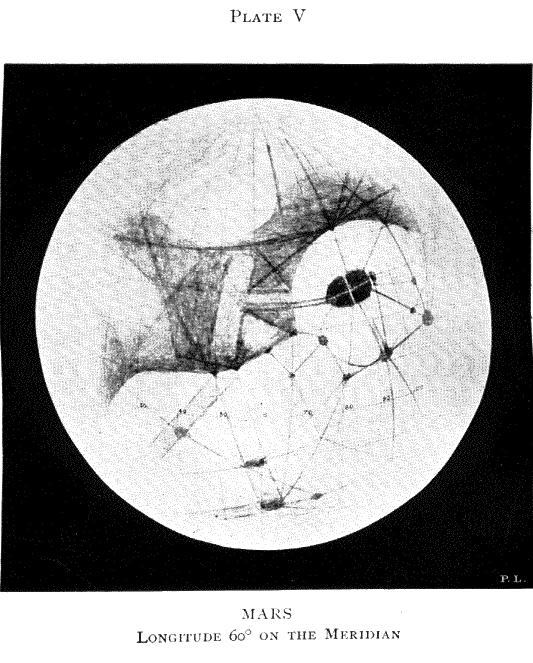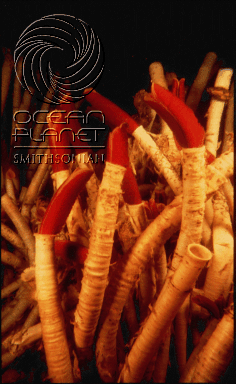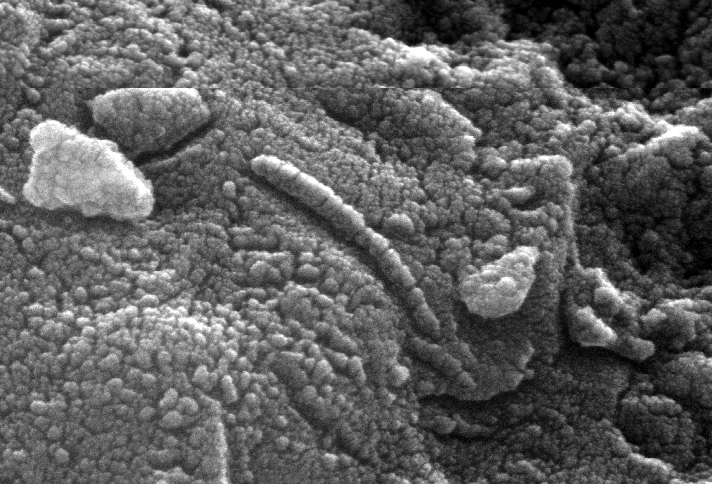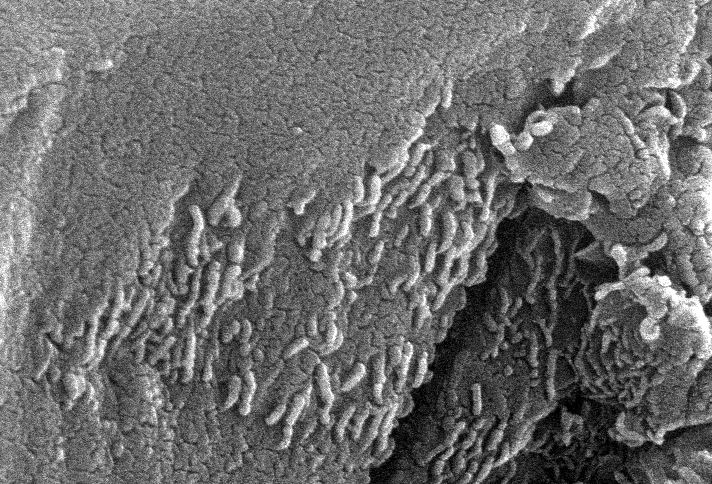
So we must realize that there are other worlds in other parts of the universe, with races of different men and different animals. --- Titus Lucretius Carus (99-55 B.C.)
Before we talk about the possibility of life elsewhere, it is fun to take a look at earlier thought on this subject. For the most part, ancient western ideas did not really consider the possibility of life beyond the Earth--except for the notion of a God or gods that existed in the "heavenly realm". Remember that the ancient Greeks thought that the planets in the sky were composed of quintessence, and thus nothing as imperfect as life (which is born and dies) could exist there. Thus there were not too many conjectures about life outside the sublunary realm--though, there was considerable speculation about human-like creatures elsewhere on Earth--or even inside the Earth. For example, Anaximander had modeled the Earth as a cylindrical drum-like object, with the known world on the top, and an unknown world on the bottom. Anaxagoras speculated that there might be a race of humans that lived on the Moon. But Plato and Aristotle ("There cannot be more worlds than one.") thought that the Earth was the center of everything, and thus it was not possible for other worlds to exist, nor to have them populated with life. Thus, after this philosophy took hold, there were very few attempts to populate other worlds. [However in eastern thought, Buddhism taught that there were a multitude of worlds and Universes, and that ours was not unique.]
One of the first, and best-known (western) speculations on the possibilty of life elsewhere in the Universe in post-Aristotle times is from Titus Lucretius Carus (ca. 99 to 55 BCE), or simply "Lucretius". Lucretius was a Roman poet who was a devotee to a naturalistic interpretation of the Universe that incorporated the atomism of Democritus.
"Of Lucretius' life remarkably little is known: he was an accomplished poet; he lived during the first century BC; he was devoted to the teachings of Epicurus; and he apparently died before his magnum opus, [the poem] De Rerum Natura (On the Nature of the Universe), was completed. Almost everything else we know (or think we know) about this elusive figure is a matter of conjecture, rumor, legend, or gossip. ...Indeed one does not have to read very far into the poem to discover that not only is Lucretius a serious student of philosophy and science, but that above all he is a great poet of nature. He reveals himself as a lover of woods, fields, streams, and open spaces, acutely sensitive to the beauties of landscape and the march of seasons. He proves a keen observer of plants and animals and at least as knowledgeable and interested in crops, weather, soil, and horticulture as in the existence of gods or the motion of atoms. The preponderance of natural descriptions and images in the poem has led some readers to suppose that the author must have led some form of rural existence, perhaps as the owner of a country estate. True or not, it is clearly not the city, with its hurly-burly of commerce, money grubbing, social climbing, and political strife, but the quiet countryside with its contemplative retreats, solitude, and simple pleasures that inspires his poetry and (as was the case with his master Epicurus in his garden at Athens) his philosophical reveries. ...
For the most part, the forty-four years of Lucretius' lifetime was a period of nearly non-stop violence: a time of civil wars, grueling overseas campaigns, political assassinations, massacres, revolts, conspiracies, mass executions, and social and economic chaos. Even a brief chronology of the times paints a grim picture of devastation, with each decade bearing witness to some new disturbance or uprising:
100 BC: riots erupt in the streets of Rome; two public officials, the tribune L. Appuleius Saturninus and praetor C. Servilius Glaucia, are murdered. 91 BC: the so-called Social War (between Rome and her Italian allies) breaks out. No sooner is this bitter struggle ended (88 BC) than Lucius Cornelius Sulla, a ruthless politician and renegade army commander, marches on Rome, and an even more convulsive and bloody Civil War begins. 82 BC: Sulla becomes dictator. His infamous proscription results in the arrest and execution of more than 4000 leading citizens, including 40 senators. 71 BC: Spartacus' massive slave revolt (involving an army of 90,000 former slaves and outlaws) is finally put down by Cassius and Pompey. More than 6000 of the captured rebels are crucified and their bodies left for display along the Appian Way. 62 BC: Defeat and death of Catiline. By this point in his career this former lieutenant of Sulla had become a living plague upon Roman politics and a virtual byword for scandal, intrigue, conspiracy, demagoguery, and vain ambition. Every modern reader of De Rerum Natura has been struck by the extent to which Lucretius seems to have anticipated modern evolutionary theories in the fields of geology, biology, and sociology. However, to acknowledge this connection is not to say that the poet deserves accredited status as some kind of scientific "evolutionist" or pre-Darwinian precursor. It is merely to point out that, however we choose to define and evaluate its influence, De Rerum Natura was from the 17th century onward a massive cultural presence and hence a ready source of evolutionary ideas. The poem formed part of the cultural heritage and intellectual background of virtually every evolutionary theorist in Europe from Lamarck to Herbert Spencer (whose hedonistic ethics also owed a debt to the poet) - including (though he claimed never to have read Lucretius' epic) Darwin himself."1
The pervailing ideas at the time influenced Lucretius greatly, but he also ignored convention, and speculated about many aspects of life and the Universe, including the possibility that life exists elsewhere: "Granted, then, that empty space extends without limit in every direction and that seeds innumerable are rushing on countless courses through an unfathomable universe..., it is in the highest degree unlikely that this earth and sky is the only one to have been created ... So we must realize that there are other worlds in other parts of the universe, with races of different men and different animals."2
Following Lucretius, a number of philosophers made conjectures about life elsewhere. For example, Plutarch (ca. 46 to 120 AD) suggested that the darker areas on the Moon are probably oceans of water. In what maybe one of the first examples of science fiction, Lucian of Samosata (ca. 120 to 180 AD) wrote a story about "a group of adventurers who, while sailing through the Pillars of Hercules (the Strait of Gibraltar), are lifted up by a giant waterspout and deposited on the Moon. There they find themselves embroiled in a full-scale interplanetary war between the king of the Moon and the king of the Sun over colonization rights to Jupiter, involving armies which boast such exotica as stalk-and-mushroom men, acorn-dogs, and cloud-centaurs. The human inhabitants of the Moon are also remarkable: 'Amongst them, when a man grows old he does not die, but dissolves into smoke and turns to air. They all eat the same food, which is frogs roasted on the ashes from a large fire; of these they have plenty which fly about in the air, they get together over the coals, snuff up the scent of them, and this serves for their victuals. Their drink is air squeezed into a cup, which produces a kind of dew'."3 [For a bit more of the story, go here. The entire traslation of A True Story can be found here.]

With the fall of Rome, and the ensuing dark ages, it was not until the 15th century before we encounter further speculation. One of the first is due to Nicholas of Cusa (1401 - 1464) a German Catholic cardinal who had a great interest in astronomy and calendar reform. For example, he believed that the Earth revolved around the Sun, and that the stars were other suns, that had other worlds orbiting them, and that these worlds were inhabited!
With the rise of Copernicun model for the motion of the planets (ca. 1540), the speculation about life elsewhere grew. One of the first to write on this subject was the Italian monk Giordano Bruno (1548-1600). Bruno believed "there is not merely one world, one earth, one sun, but as many worlds as we see bright lights around us," and that these worlds were inhabited. At the time these ideas were deemed to be heretical, and Bruno was brought before the Inquistion. He refused to renounce these beliefs, and was burned at the stake.
The next luminary on our quest for thought on extraterrestrials is Fontenelle:
"More than a hundred years later, the idea of the plurality of worlds began to emerge again. In 1686, Bernard le Bovier de Fontenelle, a young French writer who specialized in writing about history and the popularization of science, published Entretiens sur la pluralite des mondes (Conversations on the Plurality of Worlds). Owing a great deal to the previous work of Copernicus (the heliocentric theory of the solar system) and Descartes (particularly his theory of vortex motion of the planets to counteract Newton's idea of gravity), his work rebutted the idea of a centre to the universe and speculated on the habitation of other planets. The book was unusual in that it was the first time that scientific knowledge had been written for the public in a common language and in a manner to encourage the reader to enjoy the process of learning. Hitherto, all scientific knowledge had been written only for other scientists and usually in some classical language. Newton, for example, was at that time busy composing his monumental work Principia Mathematica philosophiae naturalis (The Mathematical Principles of Natural Philosophy) - in Latin, of course. Although much of Fontenelle's writing was founded on Descartes' erroneous vortices, this does not lessen the impact of his ideas on other worlds."4
Another interesting work from the same time period (well after Galileo's discoveries) is due the famous astronomer Christiaan Huygens (1629-1695):
"Most students will be familiar with the name of Christiaan Huygens (1629-1695) from the Huygens construction in wave optics. By the age of 30, Huygens had unfathomed the mystery of Saturn's rings and made accurate observations of the Orion Nebula. He later worked on the design of telescopes and the theories of optics and gravitation. What is not so well known, however, is the unpublished work - Cosmotheoros, or New Conjectures Concerning the Planetary Worlds, Their Inhabitants and Productions - that was found only after his death and also deals with the speculation on life elsewhere."4
With the rise of science in the 18th century, speculation about other worlds was supplanted by a search for an understanding of other worlds. Of course, one of the most important discoveries of the time was made by William Herschel, when he happened upon the planet Uranus in 1781. This was followed 65 years later by the discovery of Neputune (in 1846). Neptune was found from mathematical predictions using discrepancies in the motion of Uranus in its orbit (go here for more on the discovery of Neptune--and a tale about scientific rivalry). The triumph of mathematics and physics in predicting and understanding of the motions of heavenly bodies, combined with modern developments in instrumentation will lead to the eventual discovery of planets around other stars.
Before we completely leave the era of speculation about life elsewhere, it would be remiss to neglect Percival Lowell. Lowell was born into a wealthy New England family. As a kid, he was given a small telescope that he set up in his home, and began to observe the heavens. After his college days and some traveling, Lowell returned to the US in 1877, the year of Schiaparelli's discovery of the "canali" (Italian for "channels") on Mars. After 15 years dabbling in far-eastern culture, Lowell returned to his interest in Mars. After becoming energized by the gift of a book about the planet Mars, he began corresponding and talking to astronomers. This lead to an expedition to observe Mars where he founded a new observatory near Flagstaff, Arizona in 1894. He quickly began his observations of Mars. He was now able to see for himself the canali described by Schiaparelli--but now permuted into "canals"(!), and found many more:

When astronomers demonstrated that the darker regions on Mars were not due to oceans, speculation grew as to their nature. Lowell found that these canals, and the "oases" where two canals intersected, seemed to get darker with the coming of the Martian summer. This led him to propose that the canals were due to intelligent beings that constructed them to channel water from the Martian polar region (where there was clearly ice), to the arid and warmer equatorial regions:
"Speculation has been singularly fruitful as to what these markings on our next to nearest neighbor in space may mean. Each astronomer holds a different pet theory on the subject, and pooh-poohs those of all the others. Nevertheless, the most self-evident explanation from the markings themselves is probably the true one; namely, that in them we are looking upon the result of the work of some sort of intelligent beings. . . . [T]he amazing blue network on Mars hints that one planet besides our own is actually inhabited now."5
Lowell subsequently published a book entitled Mars where all of these ideas were laid out, with illustrations to back up his discoveries. We now know that what Lowell was seeing was probably an optical illusion due to a "connecting of the dots" between craters just below his visibility level. Regardless its real value, Lowell's work certainly made him famous, and surely influenced H. G. Wells who wrote the infamous War of the Worlds.
Astronomers soon became aware of the conditions on the planets in our solar system as well as how hard it would be to actually see planets going around other stars. Before we take a trip through the solar system (and beyond) looking for life on other worlds, it is best to begin with a survey of the conditions under which life on Earth arose, as well as the great diversity of life forms today.
It is obvious that the Earth is populated by an enormous variety of lifeforms. We are quite familiar with the plant and animals that dwell on the surface of the Earth, or in the shallow rivers, lakes and coastlines. To address the issue of life on other worlds, especially those in our own solar system, however, it is useful to examine some of the more extreme conditions under which life exists. The native flora and fauna of New Mexico are incredibly hardy---they live in a harsh environment compared to most of the rest of North America: Very little precipitation with hot summers, and relatively cold winters. These plants and animals have evolved to the point where they have little trouble living here. This is the power of evolution. But there are life forms that are even more amazing in their adaptability. These lifeforms exist where there is little free water, extremely high or low temperatures, in highly alkaline or acidic water, with no sunlight and sometimes in environments where there is very little oxygen. These mostly primitive plants and animals are give the name "Extremophiles".
The most amazing of these extremophiles are comprised of different types of microorganisms. For example, one family of "archaeal" microorganism is able to survive and prosper in boiling water! At the opposite extreme are bacteria that have been found growing in the ice in frozen lakes in Antarctica. There are a number of extremophiles that might have played a role in the earliest history of life on Earth. One of these types of bacteria, the "iron eaters", might have been one of the first forms of life on the planet--they truly appear to be able to use iron to metabolize their food in the absence of oxygen. It now appears that these type of bacteria survive throughout the crust of the Earth, and have been found in rock that is two miles below the Earth's surface! Some researchers suggest that these microscopic creatures comprise nearly all of the biotic mass of the Earth.
Other researchers suggests that life on Earth may have begun near "black smokers", thermal vents deep in the ocean:

Near these vents, whole ecosystems have developed based on primitive bacteria that eat the abundant sulfur that is spewed out of these vents. Other plants and animals live on these bacteria, and these in-turn are eaten by larger creatures such as the giant tube worms:

Other species such as shrimps, lobsters, crabs, mussels, and clams also live here. The reason these are such important findings is that the early Earth contained little food, or free oxygen. So when life arose, it had to find other sources of food such as iron and sulfur.
Perhaps the most striking evidence for how robust microscopic life can be was demonstrated in 1969. Before the manned Apollo missions to the Moon, NASA launched several unmanned missions that successfully landed on the Moon. Surveyor 3 landed on the Moon in April of 1967. In November of 1969, the astronauts Pete Conrad and Alan Bean landed the lunar module of Apollo 12 within 500 ft of the Surveyor 3 landing site:

As part of this mission, they recovered the camera of Surveyor 3 and brought it back to Earth (taking care to be sterile). When the camera lens was analyzed in the lab, they found that 50 to 100 microorganisms had survived! This was after nearly three years in a complete vacuum, high exposure to radiation, and incredibly cold temperatures with no water and no food. Clearly, life is not as fragile as one might first suspect! (And here is even more evidence for tough Earthly life.)
In 1996, a stunning announcement was made by a group of NASA researchers: they had found fossil evidence for life inside a Martian meteorite--that is a rock from the surface of Mars that had found its way to Earth:

First, how do we know its from Mars? Analysis of the gases within the meteor show they are identical with the composition of the Martian atmosphere as revealed by the two US Viking probes that landed there. The chemical composition of the rock itself is also consistent with what we know about the Martian surface (for more on these aspects of the meteorite go here). This piece of Martian crust appears to have been traveling for about 16 million years in space on its eventual voyage to the Earth, landing in Antartica about 13,000 years ago.
When the researchers looked deep inside the rock, they found peculiar chemical structures that not only looked like fossilized forms of earthly bacteria, but also had chemical compositions consistent with these types of bacteria:



Obviously, it remains difficult to completely prove that these structures are due to fossilized microscopic life, and the debate about their true nature lives on. It will take future missions to Mars to retrieve rock samples that have led a little less eventful life--more sedentary sedimentary rocks--not one that had to be blasted off of Mars to get here in the first place. Clearly, however, we have found that there are forms of life on Earth that live inside rock, and that finding these types of structures in rocks from elsewhere in the solar system would no longer be the least bit surprising. We have laid the groundwork to see if there is life is possible elsewhere in our solar system.
1From The Internet Encyclopedia of Philosophy: Lucretius (c. 99 - c. 55 BCE)
2From Lucretious (c.99-55 B.C.) by David Darling
3From Lucian of Samosata (A.D. c.120-180) by David Darling
4From Extraterrestrials? : Lucretius, Bruno, Fontenelle, Huygens and
Voltaire
5From The Planet Mars: A History of Observation and Discovery by
William Sheehan, Chapter 7: Lowell